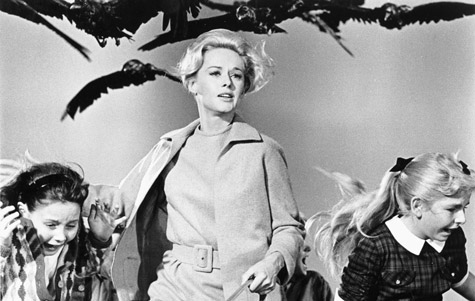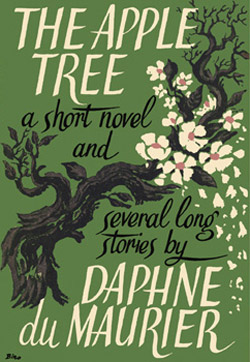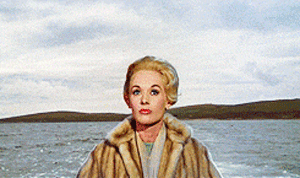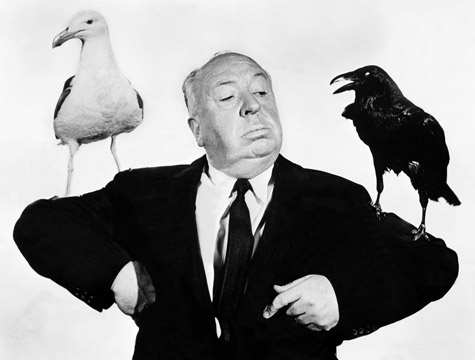
Daphne du Maurier published her story “The Birds” in her 1952 collection called The Apple Tree. Several years later, Alfred Hitchcock bought the rights to the story, and in 1963 he released it as a film with a script by novelist Evan Hunter.
Hitchcock had already filmed two du Maurier works, Jamaica Inn in 1939 and Rebecca in 1940. Jamaica Inn—starring Charles Laughton and Maureen O’Hara—did not succeed as a film, turning a brooding, atmospheric historical tale into something comedic and silly. Hitchcock himself disliked it, and it’s now considered one of his worst films.
Daphne du Maurier (who did not work on the screen adaptions from her books and stories) had such antipathy for the Jamaica Inn, she thought about withholding the sale of the film rights to Rebecca. Of course, she did end up allowing Rebecca to be made into a film, and this Hitchcock production went well, turning a big profit and winning an Academy Award for Best Picture.
So by the time Hitchcock’s Birds came out, he had a mixed track record adapting du Maurier’s work. His final film taken from du Maurier material would be a critical success and box-office winner, and it’s a popular movie to this day. More than one Hitchcock fan regards it as his last masterpiece.
But how did Daphne du Maurier view the movie? You’d think its popularity brought her new readers, people eager to check out the film’s source. In any event, her reaction to Hitchcock’s creation was clear: du Maurier did not like it. Indeed, all indications are that she hated the film.
See also: Alfred Hitchcock Is Not as Great as You Think

On December the third the wind changed overnight and it was winter. Until then the autumn had been mellow, soft. The leaves had lingered on the trees, golden red, and the hedgerows were still green. The earth was rich where the plough had turned it.
The strangeness with the birds starts immediately. Hocken observes that there are more birds around than normal—they are flying inland, hovering over the sea, and gathering by the water’s edge—and in almost no time they are launching their attacks on people. Hocken is amazed at the variety of birds involved. He recognizes finches, larks, redshanks, sanderlings, curlews, and gulls, among others, and the abruptness of the assaults shocks him.

It also surprises the reader, even if you’ve already seen the movie. The film takes its time getting to any bird attack; a single gull bloodies Melanie Daniels (Tippi Hedren) after she leaves two lovebirds at the house of Mitch Brenner (Rod Taylor). She is rowing back to the downtown section of Bodega Bay when the gull swoops down and hits her head. The aggression escalates from there in the film, but in the story the avian onslaught is heavy from the get go. Birds tap at Hocken’s family’s windows, collect on the windowsills, and fly into Hocken’s face when he opens a window out of curiosity. They also fly through an open window in his children’s bedroom and set upon his kids.
As sudden and inexplicable as they are, the initial attacks in du Maurier’s tale remind me less of what takes place in the Hitchcock adaptation than of the startling beginning to George A. Romero’s Night of the Living Dead. Du Maurier’s entire story, in fact, has a good deal in common with the zombie classic. In both, a normal day turns into a nightmare where the natural order is upended in the blink of an eye. Ned Hocken and his family, like the people holed up in the basement in Romero’s film, must fend for themselves in a besieged space—their small house—and fight to survive while trying to imagine what caused the cataclysm. Radio reports tell them certain facts about their attackers, and they learn that flocks of birds are descending on towns and cities across England, but nobody on the air can provide an explanation for what is going on.
We do get theories, however. For a while, Nate thinks that the weather has driven the birds to them. He notes that they came with the overnight onset of winter cold and a harsh wind blowing from the east. His wife discounts this reasoning, and later he runs into a farmer who tells him, “They’re saying in town the Russians have done it. The Russians have poisoned the birds.”
Nate himself does not believe this. Boarded up in his house with his wife and kids, he can only speculate on what caused the aerial invasion—and in the end, du Maurier does not give the reader closure. She gives us Nat listening to the small birds tapping their beaks against the wood he put over his windows and the noise of hawks tearing at his door. He wonders “how many million years of memory were stored in those little brains, behind the stabbing beaks, the piercing eyes, now giving them this instinct to destroy mankind with all the deft precision of machines.”
Perhaps they are just Nature’s representatives as the Earth takes revenge on mankind for the damage humans have done to it. Without question, du Maurier’s tale is an early example of the ecological disaster story, a narrative that looks ahead to a whole sub-genre in fiction. Though written in the wake of the Second World War, “The Birds” resonates today.
Read Jon McGoran's entire ecological thriller short story “Down to Zero”!
Nat and his reactions are what du Maurier focuses on in her story. Though he has a wife and child, it is Nat’s every thought and movement we follow. Du Maurier presents Nat as a father and husband protecting his loved ones, and as important as they obviously are to him, they function as background figures. So does the farmer Nat works for and the other local people with whom he converses. This is not a story about human relationships or people changing; it’s a laser-beam look at Nature in revolt, turning against human beings.
The movie version is faithful to its source in how it depicts Nature’s hostility, but Alfred Hitchcock expanded everything else and worked with Evan Hunter to create characters who most certainly do have what you might call relationship issues.
Instead of Ned Hocken, the film gives us Melanie Daniels, a cool Hitchcockian blonde. The action follows her from San Francisco up the Pacific Coast to the scenic village of Bodega Bay. There, while always dressed in her impeccably stylish clothes, she gets embroiled in a situation involving the man she’s attracted to, Mitch Bremmer; that man’s ex (played by a convincing Suzanne Pleshette); and the man’s possessive neurotic mother (Jessica Tandy).
The mother character falls right in line with the controlling mother figures in a lot of Hitchcock movies, from Notorious to Strangers on a Train to Psycho to Marnie. The idea of the powerful and twisted matriarch is one that fascinated Hitchcock, and in this case he injected it into a story it has no organic connection to.
Along with the change in setting, it is all this added human drama that du Maurier disliked. She apparently found it superfluous, a distraction from the narrative’s reason for being. She has a point. As novelist Patrick McGrath says, her story is “far bleaker, far more naturalistic” than the film.
But it’s not as if Hitchcock threw in filler to pass the time between the bird attacks. One imagines that when Hitchcock read the story, he became excited by its visual possibilities. He must have warmed to the theme of man’s vulnerability in the universe. Beneath the veneer of civilization lies terror and chaos; this is something that comes through in numerous Hitchcock films. After all, if an innocuous motel can turn into a slaughter zone for a guest, no place on earth is safe. The Birds (the movie) fits right in to the overall Hitchcock film world, and what he did with du Maurier’s story was use the premise as his foundation. Then, he and Evan Hunter built up from that premise, constructing a film that combines psychological tension with bravura set pieces in a way that is vintage Hitchcock.

Where the story jumps into the action fast, creating shock, Hitchcock’s film is a slow burn. That Hunter began the script with humorous interplay between Tippi Hedren and Rod Taylor is something Hitchcock liked. Hunter later wrote about their working relationship in his book Hitch and Me, and he said that the light-hearted start to the story pleased Hitchcock because it would keep the audience in suspense. The audience would know from the film’s title and ads that birds attack in the film, but if things got underway on a less than horrific note, the audience wouldn’t know when the birds’ assaults begin. It’s Hitchcockian strategy at its best, favoring suspense over surprise.
For all the changes and additions, the film does keep the story’s inscrutability. It never gives an explanation for the birds’ behavior. Throughout the film, we see birds in cages, birds being used by people as gifts and pets, and birds being eaten in cooked form in restaurants—Hitchcock being droll—but there’s no definite sense that the birds somehow have banded together in an act of species rebellion against their human tormentors.
As in the story, people posit theories. In the famous diner scene, a drunken man says the attacks herald the end of the world. A woman calls Melanie Daniels a witch, shrieking that Melanie is responsible for what’s happening. An ornithologist—the rationalist—stares at the attacking birds in disbelief, and one man declares that the birds can be repelled through firepower, a blast of guns, as if the birds are invading Communists. Nobody is persuasive, and nothing stops the bird storm.
And Hitchcock is true also to the tone of the story’s ending. There is no relief on the horizon, no closure. At best, the main characters—still alive—are allowed a lull. Hitchcock has spoken about the idea he had of having the family and Melanie Daniels drive away from Bodega Bay and head for safety to San Francisco, where they see the Golden Gate Bridge covered by birds. That would have been a magnificent ending, making it clear that the birds' attacks were at humankind in general and not confined to Melanie Daniels's orbit, but as the ending stands, it’s strongly suggested that the birds’ dominance is not limited in scope. Hitchcock shows the birds filling the screen, and as Evan Hunter says, “by association, the world.” In the end, he’s no kinder to humanity than Daphne du Maurier is.
See also: Page to Screen: Don't Look Now: du Maurier & Roeg
Scott Adlerberg lives in New York City. He co-hosts the Word for Word Reel Talks film commentary series each summer at the HBO Bryant Park Summer Film Festival in Manhattan. He blogs about books, movies, and writing at Scott Adlerberg’s Mysterious Island. His most recent novel is the psychological thriller Graveyard Love, available from Broken River Books.

I love The Birds.
I love the birds